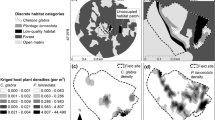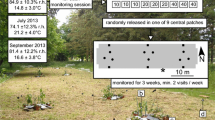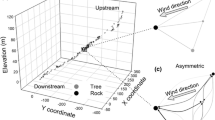Abstract
Context
Asymmetric movements, in which the probability of moving from patch i to patch j is not necessarily the same as moving in the opposite direction, may be the rule more than the exception in nature where organisms move through spatially heterogeneous environments. Empirical tests of dispersal asymmetries are rare with even fewer tests of the mechanisms driving such patterns.
Objectives
We tested for the mechanisms of asymmetric movement in the cactus-feeding insect, Chelinidea vittiger, using a combination of observational and experimental approaches.
Methods
In the observational approach, we analyzed movements from mark-recapture data in a large plot for over 4–5 generations and tested for the role of differences in patch area and wind direction driving broad-scale asymmetric movements. In the field experiment, we translocated individuals to experimental arenas where we tested for the roles of patch area, wind, presence of conspecifics, and matrix height driving directed movements at fine spatio-temporal scales.
Results
We found that population-level patterns of movements in C. vittiger were generally asymmetric. At broad scales, observational data suggested that these asymmetries were related to variations in patch size, with movements being directed from small to large patches. At fine scales, experiments showed that movement was also directed from small to large patches, but this effect was mediated by the structure of the surrounding matrix.
Conclusions
Our results illustrate how and why movement asymmetries can occur across landscapes. Accounting for such asymmetries may improve our understanding and prediction of spatially structured population dynamics and landscape connectivity.





Similar content being viewed by others
References
Acevedo MA, Fletcher RJ Jr, Tremblay RL, Meléndez-Ackerman EJ (2015) Spatial asymmetries in connectivity influence colonization-extinction dynamics. Oecologia 179:415–424
Alonso JC, Martin CA, Alonso JA, Palacin C, Magana M, Lane SJ (2004) Distribution dynamics of a Great Bustard metapopulation throughout a decade: influence of conspecific attraction and recruitment. Biodivers Conserv 13:1659–1674
Armsworth P, Bode L (1999) The consequences of non-passive advection and directed motion for population dynamics. Proc R Soc A-Math Phys 455:4045–4060
Armsworth P, Roughgarden J (2005) The impact of directed versus random movements on population dynamics and biodiversity patterns. Am Nat 165:449–465
Baguette M, Petit S, Quéva F (2000) Population spatial structure and migration of three butterfly species within the same habitat network: consequences for conservation. J Appl Ecol 37:100–108
Bender D, Fahrig L (2005) Matrix structure obscures the relationship between interpatch movement and patch size and isolation. Ecology 86:1023–1033
Bode M, Burrage K, Possingham H (2008) Using complex network metrics to predict the persistence of metapopulations with asymmetric connectivity patterns. Ecol Model 214:201–209
Bowler D, Benton T (2005) Causes and consequences of animal dispersal strategies: relating individual behaviour to spatial dynamics. Biol Rev 80:205–225
Bowman J, Cappuccino N, Fahrig L (2002) Patch size and population density: the effect of immigration behavior. Conserv Ecol 6:9
Castellon TD, Sieving KE (2006) An experimental test of matrix permeability and corridor use by an endemic understory bird. Conserv Biol 20:135–145
Compton S (2002) Sailing with the wind: dispersal by small flying insects. In: Bullock J, Kenward RE, Hails R (eds) Dispersal ecology. Blackwell Science, Oxford, UK, pp 113–133
Croft DP, Madden JR, Franks DW, James R (2011) Hypothesis testing in animal social networks. Trends Ecol Evol 26:502–507
De Vol J, Goeden R (1973) Biology of Chelinidea vittiger with notes on its host-plant relationships and value in biological weed control. Environ Entomol 2:231–240
Development Core Team R (2008) R: A language and environment for statistical computing. R Foundation for Statistical Computing, Vienna
Dey S, Goswami B, Joshi A (2014) Effects of symmetric and asymmetric dispersal on the dynamics of heterogeneous metapopulations: two-patch systems revisited. J Theor Biol 345:52–60
Diffendorfer J, Gaines M, Holt R (1995) Habitat fragmentation and movements of three small mammals (Sigmodon, Microtus, and Peromyscus). Ecology 76:827–839
Ferreras P (2001) Landscape structure and asymmetrical inter-patch connectivity in a metapopulation of the endangered Iberian Lynx. Biol Conserv 100:125–136
Fletcher RJ (2009) Does attraction to conspecifics explain the patch-size effect? An experimental test. Oikos 118:1139–1147
Fletcher RJ, Acevedo MA, Reichert B, Pias K, Kitchens W (2011) Social network models predict movement and connectivity in ecological landscapes. Proc Natl Acad Sci USA 108:19282–19287
Fletcher RJ, Acevedo MA, Robertson EP (2014) The matrix alters the role of path redundancy on patch colonization rates. Ecology 95:1444–1450
Fletcher RJ, Maxwell C, Andrews J, Helmey-Hartman W (2013a) Signal detection theory clarifies the concept of perceptual range and its relevance to landscape connectivity. Landscape Ecol 28:57–67
Fletcher RJ, Miller C (2008) The type and timing of social information alters offspring production. Biol Lett 4:482–485
Fletcher RJ, Revell A, Reichert BE, Kitchens WM, Dixon JD, Austin JD (2013b) Network modularity reveals critical scales for connectivity in ecology and evolution. Nat Commun 4:1–7
Gustafson E, Gardner R (1996) The effect of landscape heterogeneity on the probability of patch colonization. Ecology 77:94–107
Hahn BA, Silverman ED (2006) Social cues facilitate habitat selection: American redstarts establish breeding territories in response to song. Biol Lett 2:337–340
Hanski I (1998) Metapopulation dynamics. Nature 396:41–49
Henry RC, Coulon A, Travis JM (2015) Dispersal asymmetries and deleterious mutations influence metapopulation persistence and range dynamics. Evol Ecol 29:833–850
Holt R (1996) Adaptive evolution in source-sink environments: direct and indirect effects of density-dependence on niche evolution. Oikos 75:182–192
Kadoya T, Washitani I (2012) Use of multiple habitat types with asymmetric dispersal affects patch occupancy of the damselfly Indolestes peregrinus in a fragmented landscape. Basic Appl Ecol 13:178–187
Kawecki T, Holt R (2002) Evolutionary consequences of asymmetric dispersal rates. Am Nat 160:333–347
Keddy P (1981) Experimental demography of the sand-dune annual, Cakile edentula, growing along an environmental gradient in Nova Scotia. J Ecol 69:615–630
Kindvall O, Petersson A (2000) Consequences of modelling interpatch migration as a function of patch geometry when predicting metapopulation extinction risk. Ecol Model 129:101–109
Liebhold A, Koenig WD, Bjørnstad ON (2004) Spatial synchrony in population dynamics. Annu Rev Ecol Evol Syst 35:467–490
Miller C, Fletcher R, Anderson B, Nguyen L (2012) Natal social environment influences habitat selection later in life. Anim Behav 83:473–477
Moser D, Drapela T, Zaller J, Frank T (2009) Interacting effects of wind direction and resource distribution on insect pest densities. Basic Appl Ecol 10:208–215
Prevedello J, Vieira M (2010) Does the type of matrix matter? A quantitative review of the evidence. Biodivers Conserv 19:1205–1223
Prokopy RJ, Owens ED (1983) Visual detection of plants by herbivorous insects. Annu Rev Entomol 28:337–364
Pulliam H (1988) Sources, sinks, and population regulation. Am Nat 132:652–661
Ray C, Gilpin M, Smith AT (1991) The effect of conspecific attraction on metapopulation dynamics. Biol J Linn Soc 42:123–134
Revilla E, Wiegand T, Palomares F, Ferreras P, Delibes M (2004) Effects of matrix heterogeneity on animal dispersal: from individual behavior to metapopulation-level parameters. Am Nat 164:E130–E153
Rodríguez A, Andrén H, Jansson G (2001) Habitat-mediated predation risk and decision making of small birds at forest edges. Oikos 95:383–396
Salomon Y, Connolly S, Bode L (2010) Effects of asymmetric dispersal on the coexistence of competing species. Ecol Lett 13:432–441
Schick R, Lindley F (2007) Directed connectivity among fish populations in a riverine network. J Appl Ecol 44:1116–1126
Schooley R, Wiens J (2003) Finding habitat patches and directional connectivity. Oikos 102:559–570
Schooley R, Wiens J (2004) Movements of cactus bugs: patch transfers, matrix resistance, and edge permeability. Landscape Ecol 19:801–810
Schooley R, Wiens J (2005) Spatial ecology of cactus bugs: area constraints and patch connectivity. Ecology 86:1627–1639
Serrano D, Tella J (2003) Dispersal within a spatially structured population of lesser kestrels: the role of spatial isolation and conspecific attraction. J Anim Ecol 72:400–410
Serrano D, Tella J, Forero M, Donázar J (2001) Factors affecting breeding dispersal in the facultatively colonial lesser kestrel: individual experience vs. conspecific cues. J Anim Ecol 70:568–578
Skellam JG (1945) The frequency distribution of the difference between two Poisson variates belonging to different populations. J R Stat Soc Ser A-G 109:296–296
Smith A, Peacock M (1990) Conspecific attraction and the determination of metapopulation colonization rates. Conserv Biol 4:320–323
Stamps JA (1988) Conspecific attraction and aggregation in territorial species. Am Nat 131:329–347
Tilman D, May R, Lehman C, Nowak M (1994) Habitat destruction and the extinction debt. Nature 371:65–66
Travis J, French D (2000) Dispersal functions and spatial models: expanding our dispersal toolbox. Ecol Lett 3:163–165
Treml E, Halpin P, Urban D, Pratson L (2008) Modeling population connectivity by ocean currents, a graph-theoretic approach for marine conservation. Landscape Ecol 23:19–36
Vuilleumier S, Bolker B, Lévêque O (2010) Effects of colonization asymmetries on metapopulation persistence. Theor Popul Biol 78:225–238
Vuilleumier S, Possingham H (2006) Does colonization asymmetry matter in metapopulations? P R Soc B 273:1637–1642
Wang S, Haegeman B, Loreau M (2015) Dispersal and metapopulation stability. PeerJ 3:e1295
Wiegand T, Moloney K, Naves J, Knauer F (1999) Finding the missing link between landscape structure and population dynamics: a spatially explicit perspective. Am Nat 154:605–627
Wiens JA, Chr N, Van Horne B, Ims RA (1993) Ecological mechanisms and landscape ecology. Oikos 66:369–380
Wilkinson-Herbots HM, Ettridge R (2004) The effect of unequal migration rates on FST. Theor Popul Biol 66:185–197
Williams I, Frearson D, Barari H, McCartney A (2007) First field evidence that parasitoids use upwind anemotaxis for host-habitat location. Entomol Exp Appl 123:299–307
Yee TW (2015) Vector generalized linear and additive models: with an implementation in R. Springer, New York
Zeigler SL, Neel MC, Oliveira L, Raboy BE, Fagan WF (2011) Conspecific and heterospecific attraction in assessments of functional connectivity. Biodivers Conserv 20:2779–2796
Acknowledgements
We thank Madan Oli, Robert Holt, Katherine Sieving, and J. Cole Smith for their suggestions on previous versions of this manuscript. We also thank Andre Revell, Conor Egan, and Kaan Kerman for their invaluable help in the field. This work was partially funded by the National Science Foundation (DDIG DEB-1110441 and DEB-1343144).
Author information
Authors and Affiliations
Corresponding author
Electronic supplementary material
Below is the link to the electronic supplementary material.
Rights and permissions
About this article
Cite this article
Acevedo, M.A., Fletcher, R.J. The proximate causes of asymmetric movement across heterogeneous landscapes. Landscape Ecol 32, 1285–1297 (2017). https://doi.org/10.1007/s10980-017-0522-y
Received:
Accepted:
Published:
Issue Date:
DOI: https://doi.org/10.1007/s10980-017-0522-y




